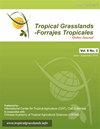灌溉对乌拉圭达丽草(Paspalum dilatatum)和巴伊亚草(P. notatum)生物量产量和成分的影响
IF 0.7
4区 农林科学
Q3 AGRICULTURE, DAIRY & ANIMAL SCIENCE
引用次数: 0
摘要
在以多年生C4草为基础的饲料生产系统中,由于生物质生产对水的响应不一致,灌溉的使用受到限制。研究了3种不同灌溉水平连续2个生长季节对巴伊亚草(Paspalum notatum)和达利斯草(P. dilatatum)生长的影响。植物的物候状态可以通过层状成分和非层状成分的比例来推断。灌水不能增加牧草的年干物质产量,但灌水影响了牧草的物候组成,两种牧草的地上部干物质积累分布都发生了变化。未来的研究应进一步研究水分亏缺对植物物候的影响,以更好地了解灌溉对植物物候的影响。本文章由计算机程序翻译,如有差异,请以英文原文为准。
Effect of irrigation on biomass production and components of dallis grass (Paspalum dilatatum) and Bahia grass (P. notatum) in Uruguay
Use of irrigation in forage production systems based on perennial C4 grasses has been limited because of inconsistent responses of biomass production to water. The effects of three different levels of irrigation on growth of Paspalum notatum (Bahia grass) and P. dilatatum (dallis grass) over two consecutive growing seasons were studied. The phenological state of the plants was inferred by the proportion of lamina and non-lamina components. While irrigation failed to increase annual dry matter yield of forage, phenological composition of forage was affected by irrigation with both species showing changes in distribution of dry matter accumulation among different above-ground plant parts. Future research on these species should study the effects of moisture deficit on phenology to better understand the effects of irrigation.
求助全文
通过发布文献求助,成功后即可免费获取论文全文。
去求助
来源期刊

Tropical Grasslands-Forrajes Tropicales
Agricultural and Biological Sciences-Agronomy and Crop Science
CiteScore
1.60
自引率
0.00%
发文量
36
审稿时长
16 weeks
期刊介绍:
The Journal publishes, in English or Spanish, Research Papers and Short Communications on research and development, as well as contributions from practitioners (Farmer Contributions) and Review Articles, related to pastures and forages in the tropics and subtropics. There is no regional focus; the information published should be of interest to a wide readership, encomprising researchers, academics, students, technicians, development workers and farmers.
In general, the focus of the Journal is more on sown (''improved'') pastures and forages than on rangeland-specific aspects of natural grasslands, but exceptions are possible (e.g. when a submission is relevant for a particularly broad readership in the pasture and forage science community).
The Journal will also consider the occasional publication of associated, but closely related, research in the form of an additional scientific communication platform [e.g. a re-make of the former Genetic Resources Communication series of the former Division of Tropical Crops and Pastures of the Commonwealth Scientific and Industrial Research Organisation (CSIRO), Australia].
Areas of particular interest to the Journal are:
Forage Genetic Resources and Livestock Production[...]
Environmental Functions of Forages[...]
Socio-economic Aspects[...]
Topics within the aforementioned areas may include: Diversity evaluation; Agronomy; Establishment (including fertilization); Management and utilization; Animal production; Nutritive value; Biotic stresses (pests and diseases, weeds); Abiotic stresses (soil fertility, water, temperature); Genetics and breeding; Biogeography and germplasm collections; Seed production; Ecology; Physiology; Rhizobiology (including BNF, BNI, mycorrhizae); Forage conservation; Economics; Multilocational experimentation; Modelling.
 求助内容:
求助内容: 应助结果提醒方式:
应助结果提醒方式:


